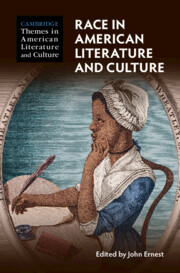Book contents
- Race in American Literature and Culture
- Cambridge Themes in American Literature and Culture
- Race in American Literature and Culture
- Copyright page
- Contents
- Contributors
- Acknowledgments
- Introduction
- Part I Fractured Foundations
- Part II Racial Citizenship
- Part III Contending Forces
- Part IV Reconfigurations
- Part V Envisioning Race
- Part VI Case Studies
- Part VII Reflections and Prospects
- Chapter 24 What Is Missing?
- Chapter 25 Traditions, Communities, Literature
- Chapter 26 Children of the Future
- Chapter 27 Presidential Race
- Index
Chapter 25 - Traditions, Communities, Literature
from Part VII - Reflections and Prospects
Published online by Cambridge University Press: 26 May 2022
- Race in American Literature and Culture
- Cambridge Themes in American Literature and Culture
- Race in American Literature and Culture
- Copyright page
- Contents
- Contributors
- Acknowledgments
- Introduction
- Part I Fractured Foundations
- Part II Racial Citizenship
- Part III Contending Forces
- Part IV Reconfigurations
- Part V Envisioning Race
- Part VI Case Studies
- Part VII Reflections and Prospects
- Chapter 24 What Is Missing?
- Chapter 25 Traditions, Communities, Literature
- Chapter 26 Children of the Future
- Chapter 27 Presidential Race
- Index
Summary
This essay reflects on how Indigenous communities have maintained their own literary canons, often outside the mechanisms that literary scholars tend to associate with canonicity: large institutional archives, formal publishing and republishing, placement in major anthologies and college syllabi. The essay argues that Indigenous canonicity is not a static tradition from which texts can be either lost or added; it is not a privatized or extractive business. Rather, it is a collective, contributive process in which tribal members share in the multiple functions of editing, archiving, writing, reading, interpreting, and publishing. These community-based processes and conversations turn up a wealth of essays, poems, recipes, and histories that haven’t typically attracted the attention of settler teachers, publishers, or collecting institutions – perhaps because they were not written for settlers. The Indigenous literary histories that Indigenous communities remember and cherish, instead, document and imagine who the people are, where they come from, and where they are going. The essay concludes with a reflection on Abenaki scholar Lisa Brooks’s notion of “the gathering place” – referring to any collective exercise of Indigenous cultural authority and exchange – as a model of Indigenous writing and canon making.
- Type
- Chapter
- Information
- Race in American Literature and Culture , pp. 410 - 418Publisher: Cambridge University PressPrint publication year: 2022

